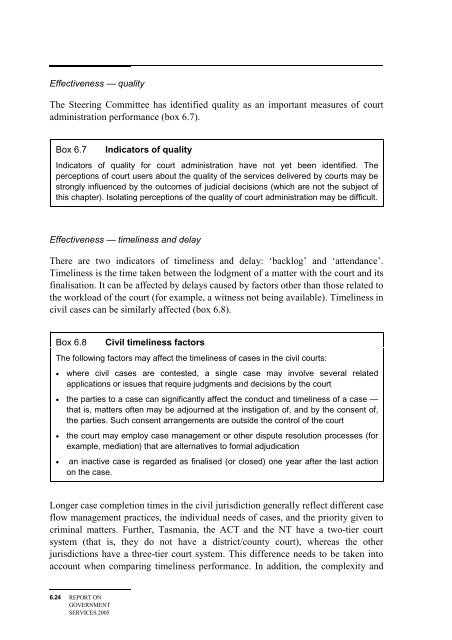PDF 0.4 MB
PDF 0.4 MB
PDF 0.4 MB
Create successful ePaper yourself
Turn your PDF publications into a flip-book with our unique Google optimized e-Paper software.
Effectiveness — quality<br />
The Steering Committee has identified quality as an important measures of court<br />
administration performance (box 6.7).<br />
Box 6.7<br />
Indicators of quality<br />
Indicators of quality for court administration have not yet been identified. The<br />
perceptions of court users about the quality of the services delivered by courts may be<br />
strongly influenced by the outcomes of judicial decisions (which are not the subject of<br />
this chapter). Isolating perceptions of the quality of court administration may be difficult.<br />
Effectiveness — timeliness and delay<br />
There are two indicators of timeliness and delay: ‘backlog’ and ‘attendance’.<br />
Timeliness is the time taken between the lodgment of a matter with the court and its<br />
finalisation. It can be affected by delays caused by factors other than those related to<br />
the workload of the court (for example, a witness not being available). Timeliness in<br />
civil cases can be similarly affected (box 6.8).<br />
Box 6.8<br />
Civil timeliness factors<br />
The following factors may affect the timeliness of cases in the civil courts:<br />
• where civil cases are contested, a single case may involve several related<br />
applications or issues that require judgments and decisions by the court<br />
• the parties to a case can significantly affect the conduct and timeliness of a case —<br />
that is, matters often may be adjourned at the instigation of, and by the consent of,<br />
the parties. Such consent arrangements are outside the control of the court<br />
• the court may employ case management or other dispute resolution processes (for<br />
example, mediation) that are alternatives to formal adjudication<br />
• an inactive case is regarded as finalised (or closed) one year after the last action<br />
on the case.<br />
Longer case completion times in the civil jurisdiction generally reflect different case<br />
flow management practices, the individual needs of cases, and the priority given to<br />
criminal matters. Further, Tasmania, the ACT and the NT have a two-tier court<br />
system (that is, they do not have a district/county court), whereas the other<br />
jurisdictions have a three-tier court system. This difference needs to be taken into<br />
account when comparing timeliness performance. In addition, the complexity and<br />
6.24 REPORT ON<br />
GOVERNMENT<br />
SERVICES 2005
















